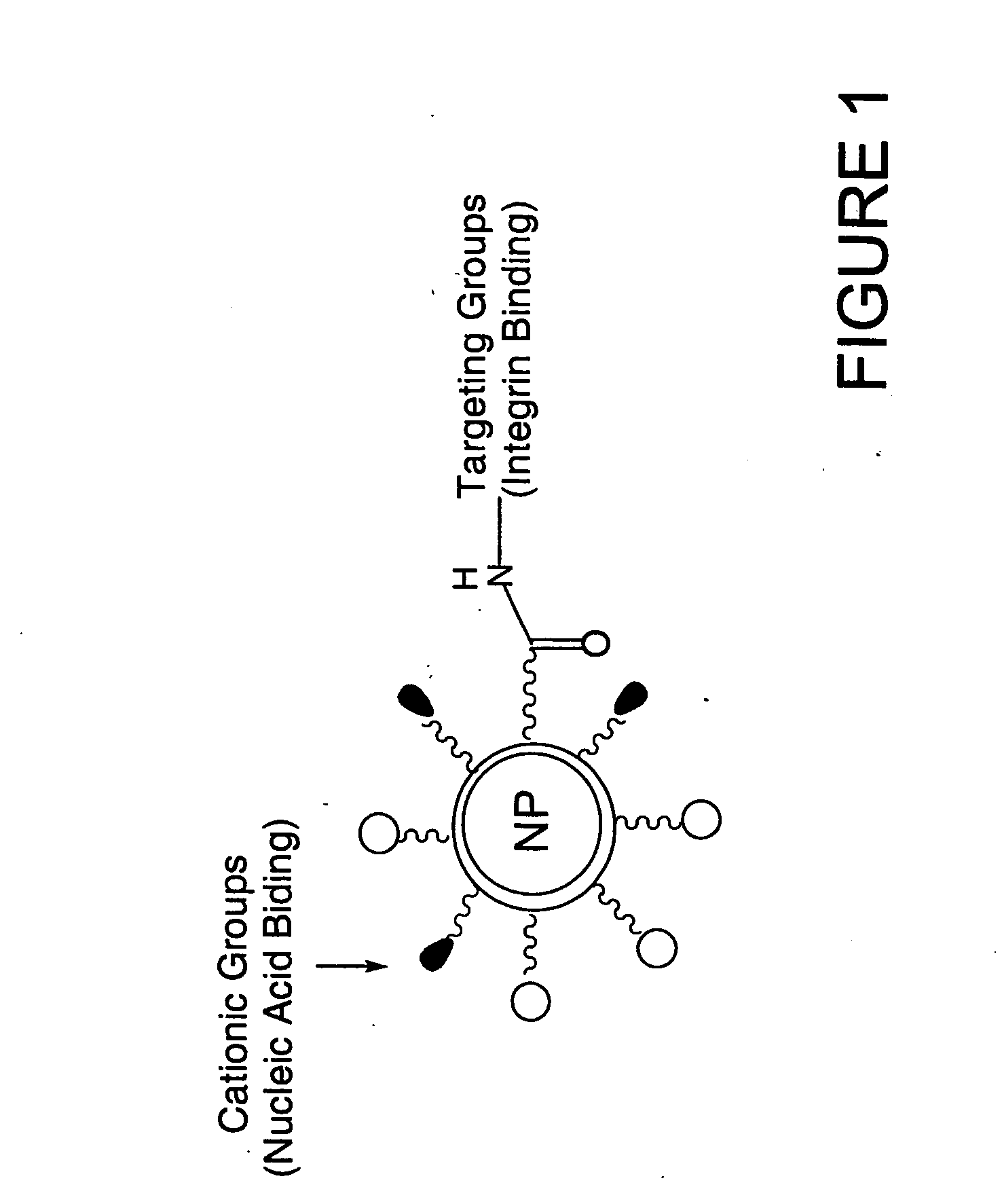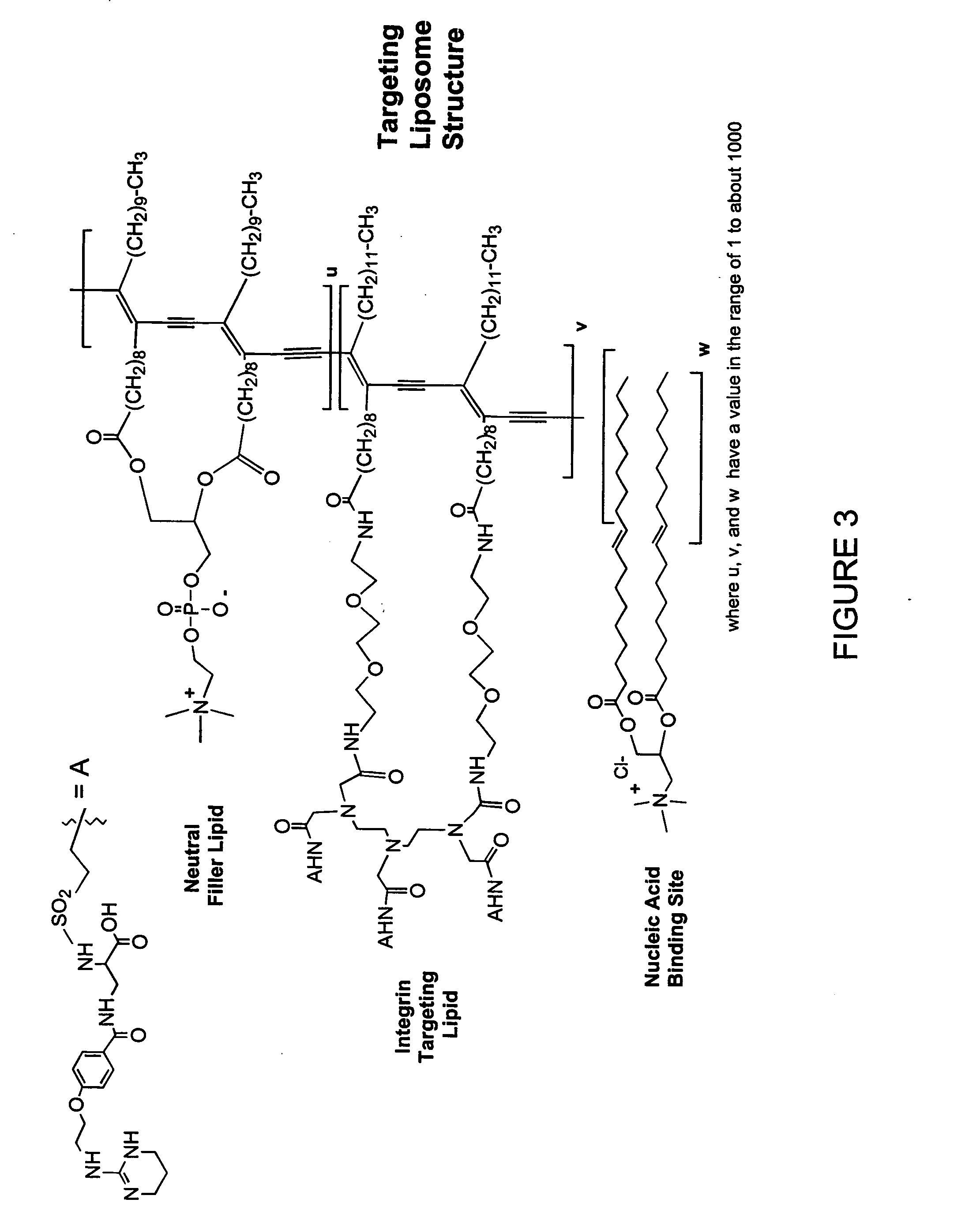Delivery system for nucleic acids
a delivery system and nucleic acid technology, applied in the direction of drug compositions, cardiovascular disorders, sense disorders, etc., can solve the problem of elusive biological function of many of the integrins
- Summary
- Abstract
- Description
- Claims
- Application Information
AI Technical Summary
Benefits of technology
Problems solved by technology
Method used
Image
Examples
example 1
Cell Adhesion Assay
[0112] Cell adhesion inhibition study was done on plates coated with vitronectin using human melonoma cell line M21. The multivalent liposomes NP1-NP6 as well as the monomeric ligand 10 were separately incubated with M21 cells and applied onto the 48 well plates coated with vitronectin. After about 1 hour incubation, the wells were washed, and the cells that adhered were stained with a solution of crystal violet and the optical density (OD) at about 590 nm was measured. The OD measured was proportional to the number of cells bound to the vitronectin plate and was plotted against the concentration of component 10 on the surface of the NPs in different formulations to calculate the IC50.
[0113]FIG. 8 schematically depicts the cell adhesion assay wherein M21 human melanoma cells, which express αvβ3, were mixed with liposomes covalently conjugated to an integrin antagonist (ligand) or to ligand alone. The cells were then placed on vitronectin plates, washed and stain...
example 2
In Vitro Transfection Assay
[0115] About thirty nanomoles of cationic liposomes NP5 and NP6, with or without covalently conjugated αvβ3-targeting ligand, respectively, were each complexed to about 2 μg of plasmid DNA encoding green fluorescent protein (GFP) in 5% dextrose and then exposed to melanoma cells in vitro for about 1 hour. Transfection efficiency was assayed by counting the number of fluorescent cells as compared to total cell number after 24 hours. The cells used were human melanoma cells M21 and M21L. M21 cells express αvβ3 integrin while M21L cells do not express αvβ3 integrin (αv-null).
[0116] As shown in FIG. 10, the αv expressing cells (M21) that were treated with the targeted liposome (NP5) complexed with the GFP gene exhibited a 5-fold or greater degree of transfection (>125,000 cells / million) compared to αv-expressing cells that were treated with non-targeted liposomes (NP6) (no antagonist; about 25,000 cells / million) or DNA alone (no liposome, about 12,000 cells / ...
example 3
Targeting Liposome-Mediated Gene Delivery is Targeted to the Tumor in vivo
[0117] About 450 nanomoles each of NP5 and NP6, were electrostatically complexed to about 30 μgs each of plasmid DNA encoding firefly luciferase in about 200 μls each of 5% dextrose and then each liposome complexed DNA solution was intravenously injected into animals bearing about 150 mm3 subcutaneous melanomas lacking αvβ3 expression (M21L). After about 24 hours the animals were sacrificed, the described organs and tumors were excised, and assayed for luciferase activity. Luciferase activity was assayed using the Bright-Glo luciferase assay kit (Promega Corp., Madison, Wis.) according to manufacturer's directions with the exception that whole organs were ground using a tissue grinder in an amount of Bright-Glo lysis reagent normalized to weight of the organ.
[0118] As shown in FIG. 11, the targeted liposome (NP5), complexed with luciferase gene, exhibited a highly selective expression in the tumor tissue rel...
PUM
| Property | Measurement | Unit |
|---|---|---|
| size | aaaaa | aaaaa |
| MW | aaaaa | aaaaa |
| MW | aaaaa | aaaaa |
Abstract
Description
Claims
Application Information
 Login to View More
Login to View More - R&D
- Intellectual Property
- Life Sciences
- Materials
- Tech Scout
- Unparalleled Data Quality
- Higher Quality Content
- 60% Fewer Hallucinations
Browse by: Latest US Patents, China's latest patents, Technical Efficacy Thesaurus, Application Domain, Technology Topic, Popular Technical Reports.
© 2025 PatSnap. All rights reserved.Legal|Privacy policy|Modern Slavery Act Transparency Statement|Sitemap|About US| Contact US: help@patsnap.com



